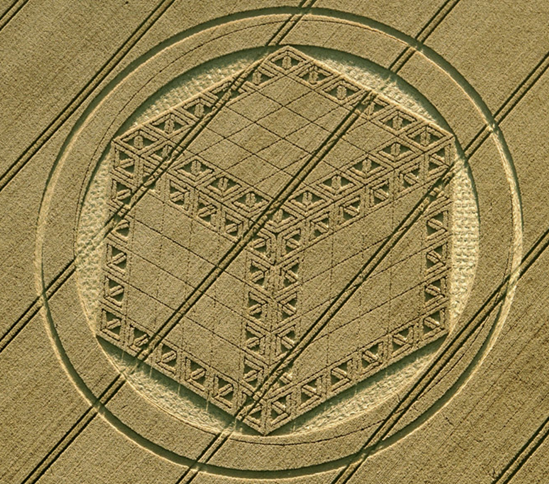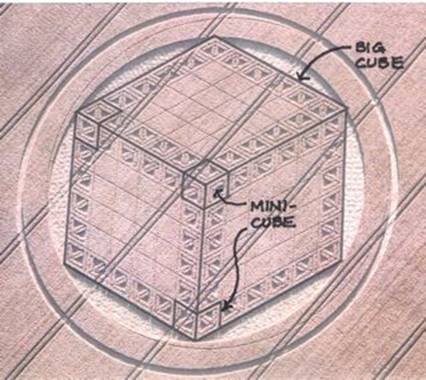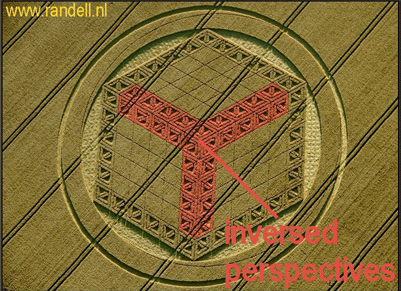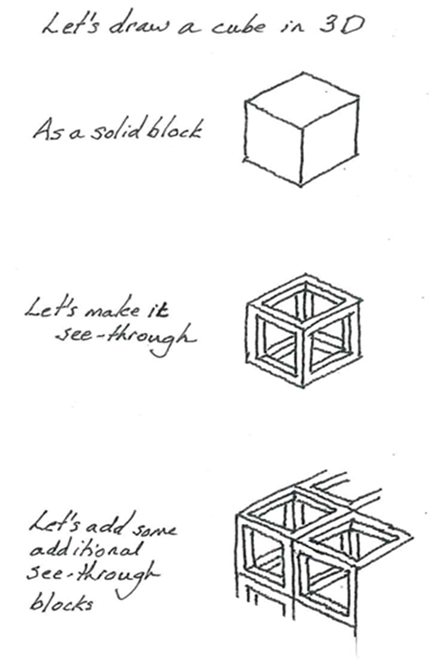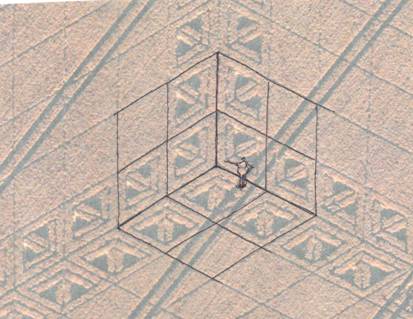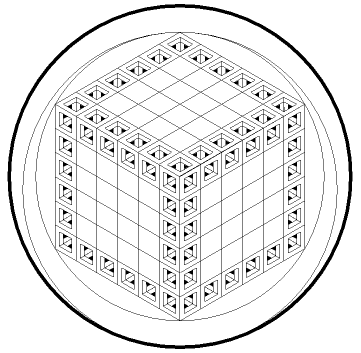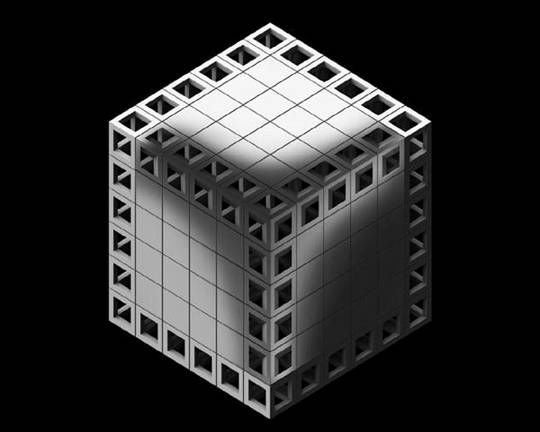|
The 2012 Hackpen Hill Formation: A Spatial Paradox by Sarah Susanka (26.03.2013) http://en.wikipedia.org/wiki/Sarah_Susanka
I have been working with the Hackpen Hill crop circle formation on and off ever since the day it arrived on August 26th, 2012. This formation, which I’ve affectionately named “The Cube of Space,” has great significance for me, as the geometry of the cube and, its further geometrical implications, has for years been an ongoing inquiry of mine. My objective in writing this article is to give you a taste of what I see in the geometry of the formation itself – specifically the cube (I have not concerned myself here with the outer circles, though these obviously have great significance also) – and what is implied by the shift in perspective that is required to see this formation clearly. In this article I will take you, step by step, through the process of learning to see the shift in perspective that we are being shown through the language of geometry. And in a forthcoming article, I will use this shift in perspective to open the door to what I believe the geometry of this formation points toward. As you read on, I recommend that you keep a copy of the above photograph at hand, so that you can orient yourself to the various features I’ll be drawing your attention to as we go. For me, the Hackpen Hill formation is a powerful visual koan (a Zen term that means “a paradoxical riddle that reaches beyond the boundaries of intellect to open the mind to Truth”). As a student of the inner work to understand who and what we are, I have found that the inquiry process that this formation has inspired in me is one of the most profound of a lifetime. To share what I’ve come to understand, you’ll need to engage it with your own inquiry process. I assure you, if you do, you will not be disappointed. If there were any remaining doubt I’d had about what these crop circles are showing us, this formation has removed them, confirming my strong suspicions that we are being taught. Although I cannot say by what, in the willingness to look and to engage in the inquiry, the teachings have stepped forth from the field in which the message was delivered. Perhaps the old adage, “When the student is ready, the Teacher will appear”, should be rephrased to say, “When the students are ready, the Teachings will appear.” Each formation seems perfectly tailored to each researcher’s particular interest and symbolic vocabulary, and more often than not a single formation speaks to multiple individuals with equal intensity and significance. As with any inquiry, my own search began with a question that I suspect many of us who are intrigued by the crop circle phenomenon hold. I wanted to know where these crop circle artists might be “located” in relation to our point of orientation in space and time. I believe that this crop circle is giving us at least the beginning of an answer to that question. Seeing the Shift in Perspective First let’s take a look at the overall geometrical layout.
Notice that the big cube depicted in the formation is made up of multiple mini-cubes. If we were looking down at a normal three-dimensional cube, the mini-cube at the very center of the image would be the closest corner of the cube to our viewing point.
You can see this very clearly in this photo of a Rubik’s Cube. Now here’s where we have to start looking at the formation very carefully. If you look closely, you will see that the three line segments of mini-cubes shaded in red in the diagram below are inverted, when compared with the ones around the outside of the cube. The diagram below, from www.randel.nl, shows this well. Don’t worry if you can’t see it yet. I’ll show you how in a moment.
As an architect, I draw window frames in perspective all the time, so it’s very apparent to me that the way that these lines of see-through cubes have been drawn is actually upside-down and inside-out from what our eyes would expect to see at the top outward pointing corner of the depicted cube. This tells me that we are being shown an upside down world beyond the boundaries of, and on the other side of the cube. You can get a taste of this for yourself, if you are three dimensionally adept, by turning the above image upside down.
If you allow your eyes to make the middle point of the cube into an inside corner, rather than an outward pointing corner, you may be able to see what I mean. But for those who have difficulty seeing this right away (and believe me, most people do find it difficult, so don’t fault yourself for being slow. You’re not. This is sophisticated stuff), let me take you through the visual steps. Step 1--Each of those black triangles you see in the photo of the formation is actually part of the rendering of a mini 3D cube. To see this, let's look at how you draw a cube.
Notice that in order to give the see-through cube thickness, and draw it in perspective, each edge of the cube is drawn so that it forms part of a kind of window frame, through which you see the parts of the cube that are further back in space, further back in perspective. In the Hackpen Hill formation, each side of the large cube represented by the entire diagram is composed of these stacked see-through cubes, each one drawn in this way. Step 2-- Now let's look at the center three legs of the cube. Normally our eye would assume that these legs were extending forward in perspective, toward us, the viewer seeing the diagram from an aerial perspective, just as in the second drawing down, above. But that's not what's represented.
To understand what the crop circle artists have presented us, I have turned the middle of the formation upside down, and in the diagram below, I’ve drawn a "little guy" to show you the perspective that this part of the formation is being seen from.
Using the same conventions of perspective as in my cube drawings above, we can see that the "window frame" of the side of each mini-cube is showing us the angle that it is being seen from. It’s as though our “little guy” is standing in a huge cubic room, looking out, to the space beyond. And it’s also our perspective if we are looking into the far interior corner of the cube when the diagram is upside down like this. Notice that this space exhibits the same structural framework as the exterior sides of the overall cube formation, except that these mini-cubes are seen to exist beyond the surface of the cube—beyond the interior corner where “little guy” is standing, and beyond the far corner of the inverted cube we are looking at here. From where he’s looking, there’s an infinite amount of space that he can see into beyond the boundaries of the cube. This all makes sense as long as we keep looking just at this middle section above. Step 3-- But now look what happens when we place the above drawing in the center of the overall formation.
Our little guy is now in an inverted position in reference to the large overall cube and he's in an internal corner, even though it appears to our eye that this should be the part of the cube that is pointing outward toward us (revisit the Rubik’s Cube image here, if you are confused here). The mind boggles at this. We can't make it make logical sense, and yet I am certain, given what I know about drawing and perspective, that this is the hidden message. Step 4—There are some valuable graphics that various crop circle researchers and graphic artists have done to work through the dimensional implications of this challenging formation, which you can find at: http://www.cropcircleconnector.com/2012/hackpenhill3/diagrams.html Below, I include a few of these graphics, from the website Last of Days, to aid in the visualization of what I’ve described above. However, I disagree with the titling on their site of the first two graphics. The titles, “Scrambled Original”, and “Corrected Version,” both imply that the crop circle artists made a mistake in their design. I believe this was not a mistake, but a way to show us that there is something beyond our own limited perspective. So I’ve substituted my own titles, to aid in seeing more clearly what I’ve presented above. What we would expect the cube to look like:
What actually appeared in the field:
If you flip back and forth between these two, you will be able to see the difference very clearly. (Remember—the differences are most readily seen in the very center of the diagram.) There is one final graphic that may also be helpful to you in visualizing both these perspectives simultaneously. It’s a graphic created by an artist who is not named on the crop circle connector site, but who deserves kudos for their artistry. The illustration below magically allows one to hold both the image of the standard cube, and the inward pointing "room" in mind simultaneously, thanks to the shadowing that’s been added. Otherwise you have to use intellect to switch from one perspective to the other.
Once you are able to see the involution of perspective
described above, it’s possible to ponder the visual koan that
has been presented with this formation. Without this preparatory
work though, the formation might seem fascinating and beautiful,
but it can only reveal a tiny piece of its message. In a few
weeks, I’ll share here the amazing journey that my own inquiry
into this formation has precipitated, but before I do, I hope
you’ll spend some time with this koan, and begin an inquiry into
what it might mean for you as well. I’m coming to believe that as with dreams, when we ponder the crop circle formations that speak to us, we will often receive a kind of insight that seems perfectly and miraculously tailored to our own inner journey or our own interests. This does not negate different meanings that might be found by other researchers. It is the earnestness of the inquirer that matters. The meanings we find along the way we can share with one another, but it is through the inquiry process itself that transformation occurs. This is what the great mystics of all ages know, but they can only point the way with their words. Their students must engage what they have been given. I believe that this is what is being asked of us—to engage in the inquiry at an individual level, in order to see beyond the apparent limits of our current perceptions. This formation provides a stepping stone along that path. Happy inquiring! |
